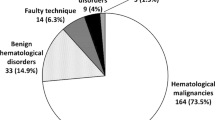Abstract
Bone marrow necrosis (BMN) is a rare phenomenon in children with malignancies, occurring most commonly in patients with acute lymphoblastic leukemia (ALL). The pathophysiology of this phenomenon has not been identified. We analyzed seven BMN cases with ALL in order to elucidate the underlying mechanism. Serum high-mobility group box 1 (HMGB1), cytochrome C, cytokines, and chemokines were measured, and real-time quantitative reverse transcription-polymerase chain reaction (RQ-RT-PCR) and immunochemistry of death-related molecules were analyzed using bone marrow samples. The serum levels of 17 of 27 cytokines and chemokines were found to be significantly elevated in patients with BMN in comparison to those in healthy volunteers; however, IFN-γ and IL-10 were not elevated. The cytokine pattern was different to that reported in hemophagocytic lymphohistiocytosis. The HMGB1 and cytochrome C levels in patients with BMN were not elevated. RQ-RT-PCR revealed significant overexpression of Fas-ligand, perforin, and granzyme B in the bone marrow of patients with ALL complicated with BMN compared with that in healthy volunteers and in patients with ALL without BMN. On immunohistochemistry, we identified leukemic cell-eliciting Fas-ligand and macrophage-eliciting TNF-α. Thus, no close relationship with massive necrosis or the intrinsic pathway of apoptosis was identified in the occurrence of BMN. These results suggest that the massive cell death phenomenon called BMN is partially induced by the extrinsic pathway of apoptosis.

Similar content being viewed by others
References
Wade L, Stevenson L. Necrosis of bone marrow with fat embolism in sickle cell anemia. Am J Pathol. 1941;17:47–54.
Janssens AM, Offner FC, Van Hove WZ. Bone marrow necrosis. Cancer. 2000;88:1769–80.
Kiraly JF 3rd, Wheby MS. Bone marrow necrosis. Am J Med. 1976;60:361–8.
Paydas S, Ergin M, Baslamisli F, Yavuz S, Zorludemir S, Sahin B, et al. Bone marrow necrosis: clinicopathologic analysis of 20 cases and review of literature. Am J Hematol. 2002;70:300–5.
Pui CH, Stass S, Green A. Bone marrow necrosis in children with malignant disease. Cancer. 1985;56:1522–5.
Knupp C, Pekala PH, Cornelius P. Extensive bone marrow necrosis in patients with cancer and tumor necrosis factor activity in plasma. Am J Hematol. 1988;29:215–21.
Shah NR, Landi DB, Kreissman SG, Kulbachi E, Moran C. Presentation and outcomes for children with bone marrow necrosis and acute lymphoblastic leukemia: a literature review. J Pediatr Hematol Oncol. 2011;33:e316–9.
Tang Y, Xu X, Song H, Yang S, Shi S, Wei J, Pan B, et al. Early diagnostic and prognostic significance of a specific Th1/Th2 cytokine pattern in children with haemophagocytic syndrome. Br J Haematol. 2008;143:84–91.
Xu XJ, Tang YM, Song H, Yang SL, Xu WQ, Zhao N, et al. Diagnostic accuracy of a specific cytokine pattern in hemophagocytic lymphohistiocytosis in children. J Pediatr. 2012;160(984–990):e1.
Hicks DG, Gokan T, O’Keefe RJ, Totterman SM, Fultz PJ, Judkins AR, et al. Primary lymphoma of bone: correlation of magnetic resonance imaging features with cytokine production by tumor cells. Cancer. 1995;75:973–80.
Javaherian K, Liu JF, Wang JC. Nonhistone protein HMG1 and HMG2 change the DNA helical structure. Science. 1978;199:1345–6.
Lotze MT, Tracey KJ. High-mobility group box 1 protein (HMGB1): nuclear weapon in the immune arsenal. Nat Rev Immunol. 2005;5:331–42.
Palumbo R, Sampaolesi M, De Marchis F, Tonlorenzi R, Colombetti S, Mondino A, et al. Extracellular HMGB1, a signal of tissue damage, induces mesoangioblast migration and proliferation. J Cell Biol. 2004;164:441–9.
Scaffidi P, Misteli T, Bianchi ME. Release of chromatin protein HMGB1 by necrotic cells triggers inflammation. Nature. 2002;418:191–5.
Wang H, Bloom O, Zhang M, Vishnubhakat JM, Ombrellino M, Che J, et al. HMGB-1 as a late mediator of endotoxin lethality in mice. Science. 1999;285:248–51.
Adachi N, Hirota M, Hamaguchi M, Hamaguchi M, Okamoto K, Watanabe K, et al. Serum cytochrome C level as a prognostic indicator in patients with systemic inflammatory response syndrome. Clin Chim Acta. 2004;342:127–36.
Nunoi H, Mercado MR, Mizukami T, Okajima K, Morishima T, Sakata H, et al. Apoptosis under hypercytokinemia is a possible pathogenesis in influenza-associated encephalopathy. Pediatr Int. 2005;47:175–9.
Hosoya M, Kawasaki Y, Katayose M, Sakuma H, Watanabe M, Igarashi E, et al. Prognostic predictive values of serum cytochrome c, cytokines, and other laboratory measurements in acute encephalopathy with multiple organ failure. Arch Dis Child. 2006;91:469–72.
Lickliter JD, Kratzke RA, Nguyen PL, Niehans GA, Miller JS. Fas ligand is highly expressed in acute leukemia and during the transformation of chronic myeloid leukemia to blast crisis. Exp Hematol. 1999;27:1519–27.
Volm M, Zintl F, Sauerbrey A, Koomägi R. Expression of Fas ligand in newly diagnosed childhood acute lymphoblastic leukemia. Anticancer Res. 1999;19:3399–402.
Pituch-Noworolska A, Gawlicka M, Wotoszyn M, Balwierz W, Strojny W, Zembala M. Tumor necrosis factor alpha (TNF-α) and leukaemic cells: secretion and response. Clin Lab Haemtol. 1998;20:231–8.
Friesen C, Herr I, Krammer PH, Debayin KM. Involvement of the CD95 (Apo-1/Fas) receptor/ligand system in leukemic cells. Nature Med. 1996;2:574–7.
Author information
Authors and Affiliations
Corresponding author
Ethics declarations
Conflict of interest
The authors declare that they have no conflict of interest.
Electronic supplementary material
Below is the link to the electronic supplementary material.
About this article
Cite this article
Moritake, H., Obara, M., Sameshima, N. et al. Analysis of the molecular mechanism underlying bone marrow necrosis with acute lymphoblastic leukemia. Int J Hematol 102, 349–356 (2015). https://doi.org/10.1007/s12185-015-1843-8
Received:
Revised:
Accepted:
Published:
Issue Date:
DOI: https://doi.org/10.1007/s12185-015-1843-8




